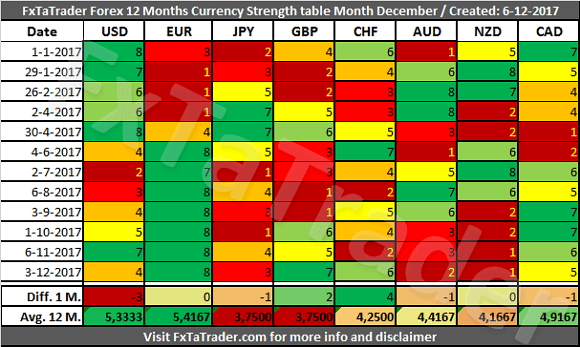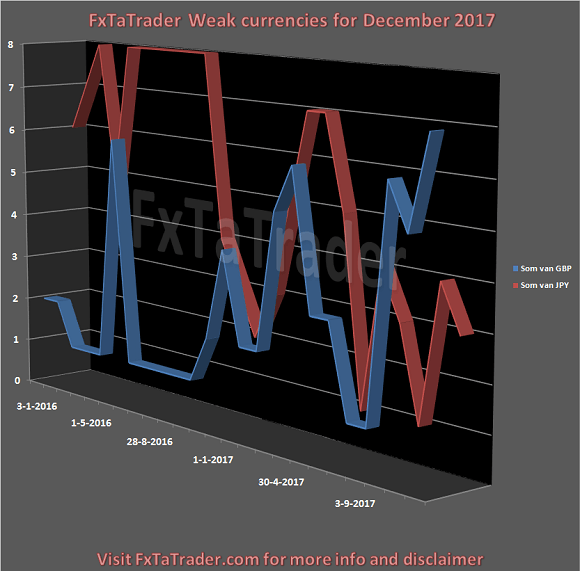In the Currency Strength table, the EUR was the strongest currency again while the NZD was the weakest. There were some significant changes last month with the CHF gaining 4 points, the GBP 2 points, the USD losing 3 points. The other currencies remained around the same level of last month with a maximum change in the strength of just 1 point.
The GBP and EUR showed a good performance during the whole month. The EUR is a Strong currency and fits exactly with the current performance in the Classification and Score.
The NZD and AUD showed a weak performance during the whole month. Both are Neutral currencies and do not fit with the current performance in the Classification and Score. However, being Neutral currencies it may offer some good opportunities against the Strong currencies.
Based on the development as described above it seems that going long with the EUR against the NZD or AUD may offer good opportunities. If this is being confirmed by the analysis in both of my Monthly articles and the charts are looking in the right direction, these combinations may offer good opportunities.
______________________________________
12 Months Currency Score Strength
The 12 Months Currency Strength and the 12 Months Average are provided here below. This data and the "12 months Currency Classification" are considered for deciding on the preferred range. Because it is not ideal nor desired to change the range for a currency every single month, we perform several checks to avoid this.
- First of all the strength over a period of the last 12 months is considered. See each row for more information.
- Next, the 12 months average is considered, see the last row called "Avg. 12 M."
- The number of months that a currency was stronger than another currency can also be considered.
- The Technical Analysis (TA) Charts for each Time Frame could also be consulted.

_____________________________________
Average 12 M. Score
When looking at the Average 12 M.. Score we can see the currencies grouped together according to their classification.
- Strong - We can see that the USD, EUR and the CAD are clearly grouped together as Strong currencies around an Average 12 M. Score of 5.
- The EUR is the strongest currency and continues to deliver high Scores.
- Neutral - The AUD, NZD and CHF are grouped together around an Average 13 wks. Score of 4,3.
- The CHF changed classification from Weak to Neutral.
- Weak - The GBP and JPY are grouped together around an Average 13 wks. Score of 3,5 to 4.
- The GBP continues to show a lot of strength with a score of 7 but lost a lot of strength in the previous months. It remains together with the JPY the weakest currency of all based on the Average 12 M. Score.
_____________________________________
Classification review
This month we take a look at the Weak currencies. There is a big difference between both currencies. While the GBP seems to recover, the JPY seems to be weakening. Looking further into the past it is clear to see that it happened also in the year 2016. Back then it stayed that way for a long time. Currently, we will have to see if the conditions will remain the same for a longer time.
Below you can see the Monthly Currency Score Chart with the 24 months' data as a reference.

For analyzing the best pairs to trade looking from a longer-term perspective the last 12 months Currency Classification can be used in support.
The CHF changed classification last month from Weak to Neutral. Here below you can see the new classification.
New Classification
This classification was updated on 6 December 2017 and is provided here for reference purposes:
Strong: USD, EUR, CAD. The preferred range is from 6 to 8.
Neutral: AUD, NZD, CHF. The preferred range is from 3 to 5.
Weak: JPY, GBP. The preferred range is 1 to 2.
_____________________________________
Currency Score Comparison
"Comparison table" and the "Ranking and Rating list"
The Forex Currency Comparison Table compares each currency with its counterpart based on the Currency Score. For more information about the currency Score of this month, you can read the article "Forex Ranking,Rating and Score" which is published every month together with this article.
By using the comparison table directly below you can get a view without the volatility and statistics as opposed to the "Ranking and Rating list". Only the strength of each currency against the counterparts is analyzed by using the Technical analysis charts of the 4 Time Frames that are also used for the "Ranking and Rating List".
The information from the Comparison Table is the source for calculating the "Ranking and Rating List" where this list additionally uses the volatility and statistics for creating the best and worst performer in the list from number 1 to 28.
The information is published once a month and be aware that rates change during this period. The mentioned scores also change and different opportunities may show up. There are many ways to follow the rate changes. This can be done e.g. by looking at the charts and checking e.g. the Ichimoku and/or MACD in the Monthly and Weekly chart. There are also many tools, apps and websites where the movement of trading rates of currencies is shown in different automated ways. This may be in pips or through percentage differences or by comparing the values of indicators like the RSI, Moving Averages, MACD, Ichimoku etc. On my blog a Heatmap is available that can be of use also.

"Comparison table" and the "Currency Score Chart"
The additional value of this table compared to the Currency Score table is that the Comparison Table compares the strength of the currencies of each pair. By subtracting the strength of the weaker currency from the stronger currency we have a way to compare each pair combination.
The comparison table provides a way to compare currencies from a longer-term perspective of 12 months and also simultaneously taking the current trend into account. By coloring the currencies in the X and Y axis according to their Classification we can show what the best combinations are.
Comparison table Guide
- First of all better-classified currencies in combination with weaker-classified currencies can always be traded and vice versa. The Currency Score difference may be negative. In that case, the trade should be made after a pullback. In other words, a trade can then only take place after a recovery and the main trend being confirmed again.
- Second, only equally classified currencies are approved when there is a positive Currency Score difference. Also here, the trend has to be confirmed again.
The difference between point 2 and 1 is that the long trend is not clear with 2 equally qualified currencies because that pair is in a sideways market. For that reason, the Currency Score difference cannot have a negative difference. A positive difference confirms the momentum for a short revival. - Third, only Neutral currencies are Approved against a better-classified currency when there is a Currency Score difference of at least +4. In the case of a currency worse classified, the Currency Score difference has to be at least -4.
The above-mentioned situations applicable to this point may happen when there is a clear reversal and the chart is showing a new trend with good entries in the new direction. The difference between point 3 and the previous 2 points is that with point 3 a reversal in the whole market is possible when looking at all the currencies together. This gives a better chance when a trend reversal takes place compared to point 1 and 2! - By preference, each currency should be selected for a trade with a score difference as far apart from each other as possible in the range from 1 to 8. However, these opportunities are rare and for that reason point 1 offers flexibility and is the best choice to trade, point 2 is the second best and point 3 is the third best choice.
- The classification of the currencies in question may change in the longer term. Even though currencies may be in the same category a currency may be in a weaker/stronger period and may even change its classification in the future. See the current classification for the coming period at the beginning of this article.
______________________________________
Putting the pieces together
Based on the last "12 Months currency classification" and the "CurrencyComparison Table" the most interesting currencies for going long seem to be the:
EUR, CHF and CAD.
These are Strong or Neutral currencies from a longer term perspective when looking at the last "12 Months currency classification".
For going short the same analysis can be done and the following currencies seem to fit best:
NZD, AUD and JPY.
These are Weak or Neutral currencies from a longer term perspective.
The articles are my personal opinion, not recommendations, FX trading is risky and not suitable for everyone.The content is for educational purposes only and is aimed solely for the use by ‘experienced’ traders in the FOREX market as the contents are intended to be understood by professional users who are fully aware of the inherent risks in forex trading. The content is for 'Forex Trading Journal' purpose only. Nothing should be construed as recommendation to purchase any financial instruments. The choice and risk is always yours. Thank you.
Recommended Content
Editors’ Picks
EUR/USD clings to gains near 1.0700, awaits key US data

EUR/USD clings to gains near the 1.0700 level in early Europe on Thursday. Renewed US Dollar weakness offsets the risk-off market environment, supporting the pair ahead of the key US GDP and PCE inflation data.
USD/JPY keeps pushing higher, eyes 156.00 ahead of US GDP data

USD/JPY keeps breaking into its highest chart territory since June of 1990 early Thursday, recapturing 155.50 for the first time in 34 years as the Japanese Yen remains vulnerable, despite looming intervention risks. The focus shifts to Thursday's US GDP report and the BoJ decision on Friday.
Gold price lacks firm intraday direction, holds steady above $2,300 ahead of US data

Gold price remains confined in a narrow band for the second straight day on Thursday. Reduced Fed rate cut bets and a positive risk tone cap the upside for the commodity. Traders now await key US macro data before positioning for the near-term trajectory.
Injective price weakness persists despite over 5.9 million INJ tokens burned

Injective price is trading with a bearish bias, stuck in the lower section of the market range. The bearish outlook abounds despite the network's deflationary efforts to pump the price. Coupled with broader market gloom, INJ token’s doomed days may not be over yet.
Meta takes a guidance slide amidst the battle between yields and earnings

Meta's disappointing outlook cast doubt on whether the market's enthusiasm for artificial intelligence. Investors now brace for significant macroeconomic challenges ahead, particularly with the release of first-quarter gross domestic product (GDP) data on Thursday.